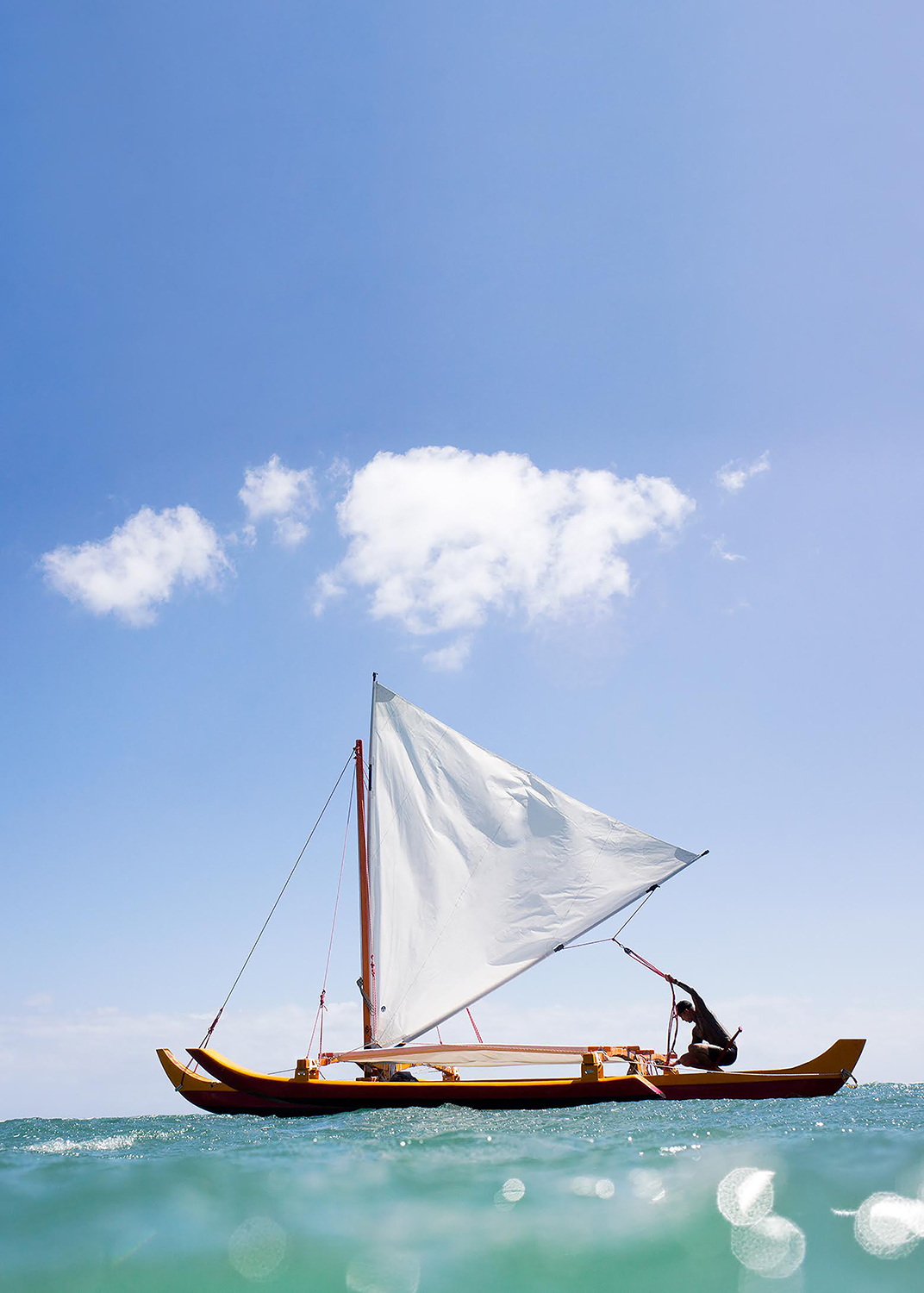FIND A RETAILER
©2022 Maui Jim, Inc. Lahaina, Hawaii
Home / Respecting Each Other & Respecting the Earth Go Hand in Hand

We caught up with Austin Kino on his travels with the Hōkūle‘a crew, his community work and other adventures.
Give us some background on the Hōkūle‘a, the Polynesian voyaging canoe. What does it mean to be a part of the crew? How were you selected?
We have close to 350 members, and everyone is a volunteer. It has been that way since it started. Everyone comes out to learn more and support the Hawaiian history of Polynesian way-finding and voyaging. A lot of people just like to sail and learn about knots and building the canoes. A whole other group loves the navigation and exploring.
Essentially, how you work your way up to getting a chance to sail is just by putting in the time. There are so many captains within the voyaging society. When a captain gets assigned a leg, say Hawaii to Tahiti, they will select their crew and some alternates, and you start to train with your crew because that’s who you are going to be living on the ocean with for up to a month.
Because we are all volunteers, that’s how we get all the work done on the canoes. Before Hōkūle‘a’s worldwide voyage, she went through a two-year dry dock. For safety, we took her all the way down to I think an inch of her original skin. It was just all of us pitching in on weekends and after work and coming down and bringing our families. From the fiberglass work to lashing her back together to sea trials, it was all volunteer time.
Tell us about this past voyage. Where did Hōkūle’a travel to?
It was a three-year circumnavigation of the globe, and as much as was possible, we tried to stay within the latitudes of the tropics. We didn’t really go up north or far south. There’s a nice map of it on www.hokulea.com/worldwide-voyage/.
What was the purpose of the voyage?
The main driver was to celebrate the theme of “Mālama Honua” that means simply to care for the earth. We took Hōkūle‘a around to share this project from Hawaii that celebrates indigenous wisdom and sustainability, because on Hawaii, because we are an island, people have to live in unison. Hōkūle‘a represents that so well. We were all on a canoe together, and we were using what nature gave us. As we went around the world, we were consciously stopping and engaging with people who are also change agents for their communities. We stopped at the United Nations. We met a lot of indigenous people, people who shared our mission about creating a more sustainable planet.
How did the logistics of the voyage work, with one crew taking over for another?
The logistics were pretty crazy. We couldn’t do it without our sponsors like Hawaiian Airlines. Most of the time, we were hosted by communities that Hōkūle‘a has historically had a relationship with. You have a host family, and they are responsible to make sure you are fed and show you around. But when that next crew flies in for the voyage, we had to make sure that we were out, so we didn’t put a strain on those communities. We didn’t want them to have to take care of two crews, just one. We were like two ships passing in the night. The next crew would fly in right as the first one was flying out. It was rare that we even get to see one another or hang out because of the logistics.
You took what you learned on the Hōkūle‘a voyage and brought it back to Hawaii. Tell us about that.
There are so many large-scale initiatives going on with sustainability. To make the most sense of it, when I came back home in between my voyages, I went to my own community and got together with a friend who was like-minded. We started small, but took what we had been inspired by on Hōkūle‘a and made it tangible for our community. We created a kid’s program, an environmental education program called Huli. The whole focus is to create opportunities for kids to get outdoors.
We are now looking at our fourth year. It started the same year as the voyage. Hawaii was so excited with everything that was going on with Hōkūle‘a, so it was a lot easier for us to get into classrooms because we were crew members. We used that as a catalyst to get our program jump-started.
Ready to grab your pair of Polarized Sunglasses by Maui Jim?
How is it going? Is it a challenge to get kids in Hawaii to get outdoors?
I honestly think one of the good things about social media has been getting people to get outside, to be active. When I see kids now, they are definitely motivated to get outside and lead a life that is active and desirable. They see what everyone else is doing now as far as ocean activities and they’re like, “Oh, I want to try that.”
A lot of canoe paddlers, swimmers, surfers and racers, they are always surrounded by the next generation and they’re extremely motivated to find a way to give back. They’re at the beaches constantly, and they see the impact more than anyone. A lot of these athletes help out with kids’ races and try to get them enjoying the ocean, because once they enjoy something then they will care about it.
What’s coming up next for you? More travel, any big trips?
I don’t foresee any long ones. I’ve been enjoying being home, being off the ocean, because I know that the training will start to take off in the next year or so for the next Hōkūle‘a voyage. The plans are still coming together as far as the route. I’m taking short weekend trips. There’s so much to see throughout the islands.
Do you have a favorite place in Hawaii or anywhere you’ve been on your travels?
That’s a hard one. Every island is so unique. I really enjoyed Tahiti, because it was like Hawaii was a hundred years ago. People there live simple lives. They’re outside. They’re very active.
In Hawaii, my favorite places change depending on the activity. If it’s surfing, it’s right here where I grew up on the south shore. But exploring the Big Island is really awesome too. You can hit so many different kinds of climates. You can go to the desert. There is everything from snow to tropical. It’s really a special place.
What does Aloha mean to you?
If I had to summarize it, Aloha is just the way you treat people. We are more connected on the islands. That’s probably true in small communities across America. What one person does really does affect other people in their community. Aloha is that respect for one another, showing kindness and acknowledging that you are a part of the larger community, that you are not separate from it, that your actions are going to affect others. What it boils down to, people who live with Aloha, that’s reflected in how they treat others.
Jump into the Aloha lifstyle with your own pair of Maui Jim Polarized Sunglasses.
©2022 Maui Jim, Inc. Lahaina, Hawaii

 Blue Hawaii Holiday Fan Photos
Blue Hawaii Holiday Fan Photos